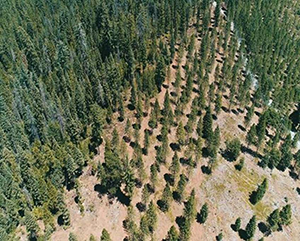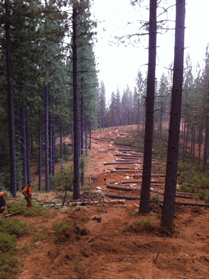
Before the Fire | Forest Management
Sierra Pacific Industries (SPI) manages all of our 2.15 million acres sustainably. What does that mean? Sustainable forest management has to keep the balance between three main pillars: ecological, economic, and socio-cultural. Forest management includes measures to protect water quality, biodiversity, wildlife habitat, species at risk, and forests with exceptional conservation value. We replant all areas that we harvest and will be increasing the stand volume for the future. While managing this renewable resource, we are also taking care of the water resources, endangered species, and flora and fauna to ensure the health of all entities of the timberland.

We have a team of about 100 professionals, including registered foresters, botanists, wildlife biologists, and other natural resource professionals tackling the sustainable management of our land in California and Washington. Together they use modern forest management practices to reduce the risk of wildfire without damaging the health of the forest. Actively thinning dense forestland and removing dry brush is key to effective fire prevention. We purposefully give our forests defensible fire space. Our foresters strategically thin spots to help stop the spread of fire – along ridges, near towns, and along major roads. This can give the firefighters clear areas to set up equipment and have a safer zone to work from. These fire breaks are a natural way to help prevent fire from spreading by removing the fuel they need to grow. These thinned areas usually have some trees, and are called "shaded fuel breaks." Many management activities can improve a forests’ resistance to drought and fire. These activities will provide positive carbon sequestration outcomes by improving forest growth rates, and reduce mortality from drought and fire.
Eric Wertz is a Registered Professional Forester that works for Sierra Pacific Industries, covering the area closest to our main office and some of our plants in Northern California. We asked Eric to share some of the things Sierra Pacific does that can benefit our land during a fire.
SPI’s management strategy can be very beneficial to help firefighters safely and more effectively fight and contain fires primarily because our lands have a much lower fuel loading. We have been managing the ground for many years, thinning out the trees, creating better spacing, and planting trees at densities more consistent with historical levels. These activities have drastically reduced the fuels available for fires to aggressively consume. The implementation of our long-term management plan has created openings in the natural stands that have been replanted with young, properly spaced trees which helps to break up the horizontal fuel continuity and can help reduce the potential for sustained crown fires or higher intensity burns under normal fire weather conditions. Additionally, because of our management practices, our ground has a well-established, and safe road network which gives firefighters the ability to safely access and fight these fires more aggressively. With our consistent management, we as a company also have a staff of foresters who have become very familiar with the ground which is very helpful during fire suppression activities as we can provide the firefighters with good information to help them more effectively fight the fires. (More on this in Part 2 of our Wildfire Blog)
~ Eric Wertz, California Registered Professional Forester
We prepare ahead of time to reduce the threat of fire. Sierra Pacific actively works with our neighbors, conservation agencies, and firefighters to make fire awareness a community issue. We curtail our woods operations on high fire danger days. We close our lands for public recreational use during high fire season. We train all of our forestry workers on the use of firefighting equipment. And we fund and maintain a private road system that is mapped and accessible for firefighting agencies.
 Fires are a part of the forest ecosystem. Plants and animals have evolved in the presence of fires but after decades of fire suppression and "hands-off" management policies, public land has unnaturally dense forests, which are prone to catastrophic wildfires. Thinning the forests has many positive results. Crowded forests contribute to fires that race through the crowns of the trees making them nearly impossible to fight, worsen the soil due to the higher-than-normal heat intensity, and unnecessarily put human lives, animal habitats, and water quality at risk.
Fires are a part of the forest ecosystem. Plants and animals have evolved in the presence of fires but after decades of fire suppression and "hands-off" management policies, public land has unnaturally dense forests, which are prone to catastrophic wildfires. Thinning the forests has many positive results. Crowded forests contribute to fires that race through the crowns of the trees making them nearly impossible to fight, worsen the soil due to the higher-than-normal heat intensity, and unnecessarily put human lives, animal habitats, and water quality at risk.

What is removed during these thinning events does not go to waste. Smaller trees can become composite material for things such as siding, flooring, and ceilings. Thinned debris could become landscape material or pet bedding. Some material could be ground up and left to biodegrade, which enriches the soil but also remains as a fuel and releases gases as it decomposes.
Then there’s biomass, which has been seen as a longshot by some, but proponents say it could become a primary market to accommodate discarded forest thinning's. The industry has struggled to gain a foothold because bioenergy is more expensive than other renewable sources such as wind and solar. There are transportation costs, for example, to get the feedstock out of the forests and to a biomass plant. Sierra Pacific’s strategic placement of sawmills to our forestland reduces that transportation cost resulting in a win-win to use what would be waste to create clean energy. Biomass from the forest floor is burned in one of our seven cogeneration facilities, creating steam to kiln dry our wood, while also turning a turbine to create energy.

Besides adhering to the strict harvesting requirements in the state of California, Sierra Pacific chooses to manage our forestland under the Sustainable Forestry Initiative (SFI). SFI Standards provide an important solution to the long-term sustainability of our forests and the markets that depend on them. As an independent, non-profit organization, SFI collaborates with its diverse network to provide solutions to local and global sustainability challenges. SFI works with the forest sector, brand owners, conservation groups, resource professionals, landowners, educators, local communities, Indigenous Peoples, governments, and universities.
There is a long list of principles under the SFI program, including Sustainable Forestry, Forest Productivity and Health, Protection of Water Resources and Biological Diversity, Research, Training and Education, and Continual Improvement – and that isn’t the whole list! There are more than 370 million acres of certified forestland and tens of millions more are positively influenced through fiber sourcing. This means that SFI has the scale and growth trajectory to ensure positive, forest-based outcomes in the marketplace.
 Vigorous and healthy forests are also resilient to threats like fire and pests. Forest fires have long played a role in the evolution and function of natural ecosystems, but we are now seeing an increase in catastrophic fires that have dire consequences for our forests, wildlife, and communities. More than a billion acres are at risk of fire each year in the U.S. In Canada, an average of about 6 million acres of land burn every year. SFI provides practical solutions that can reduce the potential for damaging wildfires through careful management including a new SFI Fire Resilience and Awareness Objective. SFI-certified organizations will be required to limit the susceptibility of forests to undesirable impacts of wildfire and to raise community awareness of fire benefits, risks, and minimization measures - things Sierra Pacific Industries has been doing for years. SFI-certified organizations will now be required to ensure forest management activities address climate change adaptation and mitigation measures.
Vigorous and healthy forests are also resilient to threats like fire and pests. Forest fires have long played a role in the evolution and function of natural ecosystems, but we are now seeing an increase in catastrophic fires that have dire consequences for our forests, wildlife, and communities. More than a billion acres are at risk of fire each year in the U.S. In Canada, an average of about 6 million acres of land burn every year. SFI provides practical solutions that can reduce the potential for damaging wildfires through careful management including a new SFI Fire Resilience and Awareness Objective. SFI-certified organizations will be required to limit the susceptibility of forests to undesirable impacts of wildfire and to raise community awareness of fire benefits, risks, and minimization measures - things Sierra Pacific Industries has been doing for years. SFI-certified organizations will now be required to ensure forest management activities address climate change adaptation and mitigation measures.

The Dixie fire, now the 2nd largest in California history, has grown to over 800,000 acres and is 55 percent contained, hopefully even more contained by the time you’re reading this. Of the seven largest California wildfires, the oldest was in 2018, the rest all in the last two years. During this horrendous fire season, we will keep the firefighters in our thoughts and hope the weather is on their side to battle these fires. You can help by being cautious and thoughtful in protecting the environment and our forestland.
Watch for Part 2 of this blog During the Fire in about two weeks.
Photo & Video credits and information: photo 1 Fire on crown of trees taken by Eric Wertz, Sierra Pacific Industries Professional Forester, photo 2 Fuel break from above. Photo taken by Eric Wertz, Sierra Pacific Industries Professional Forester, video 1 Water drop from helicopter. photo 3 Spotted Owl image taken by Sierra Pacific Industries Wildlife Biologist, photo 4 Crewmembers prepare fuel break on SPI land, photo 5 Sierra Pacific Industries cogeneration facility in Aberdeen, WA, photo 6 Boulder Creek image taken by Sierra Pacific Industries Professional Forester, photo 7 Cal Fire active fire map (8/31/21)


